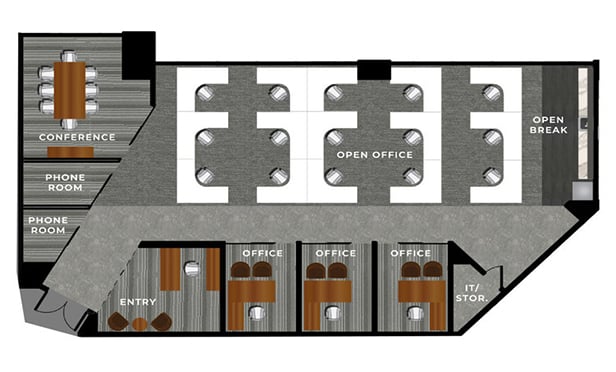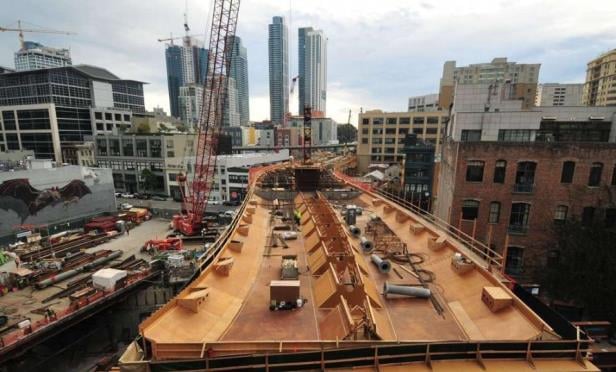
NEW YORK CITY—The coming year or two could be a momentous time for the construction trades, and therefore the contractors that employ them and, in turn, the developers that hire the contractors. It's within that time frame that the spikes in construction costs deriving from a chronic shortage of qualified labor could become more acute.
“It's a trend that has been coming for some time and has been exacerbated in different locations, but has now become a national issue,” Julian Anderson, president of consulting firm Rider Levett Bucknall, tells GlobeSt.com. The current shortage—widely acknowledged in the construction industry—had its origins in the peak of the previous cycle, he says.
“During the big boom we had in construction between 2002 and 2006, especially in housing, the numbers of people working in construction grew substantially,” Anderson says. “But even then, the number of workers available was inadequate, so a lot of the additional work was being done through overtime. The industry was very busy, people were working crazy hours—and then everything imploded, other than residential, and people left the construction industry. Architects and engineers left the business, but it this was especially true in the trades.”
Fast-forward a decade, and “construction has come back, as everybody knows,” says Anderson. In fact, there's more construction activity now than there was at the prior peak.
“But the workforce hasn't come back to the same level,” he says. “There are still fewer people working in construction than there were in 2007 or 2008. That means we have more work going on with fewer people, exacerbating what was already a problem 10 years ago.”
Not helping matters is the crackdown on immigration. Whatever one's views of undocumented or semi-documented immigrants, “it's a fact that a number of trades rely heavily on Hispanic workers,” says Anderson. “In some of those trades, workers who may not have been quite documented have gone away, and some will never surface again in the construction industry.” So not only do some specific trades—e.g., drywall, painting and terrazzo—already suffer from a labor shortage, “now there has been further compression” as well.
On top of that, Anderson says, “while regionally there are some good apprenticeship programs, nationally the industry has done a poor job of promoting apprenticeships across the board. So we have this compression of labor, the workforce is getting older—in another 10 years, there will be a lot of trouble—and the apprenticeship stream isn't there to bring in new people. The unions and the major employers in the industry are aware of this issue, but it's a significant one.”
In the interim, Anderson notes that “one of the ways in which you can overcome a labor shortage is by bringing in people who don't have the same skill sets.” But replacing, say, two qualified laborers with three semi-skilled ones and making one qualified laborer a supervisor may still mean that some of the work has to be done over, he points out.
Where this could eventually lead is to the situation that occurred in Honolulu about 12 months ago: the labor shortage in Hawaii's largest city grew so acute that some projects were put on hold due to the high costs. As it is, New York City has had a run of high costs for a few years now, and San Francisco, Los Angeles and Seattle are also “headed for trouble.” A Honolulu-like shortage in these markets isn't on the immediate horizon, but “unless there's a slowdown, at some point over the next 12 to 18 months it's going to happen.”
A contributing factor in the hottest California markets is the cost of housing, says Anderson. In much of Los Angeles, for example, the average price of a home is beyond the reach of most construction workers, meaning that they can't afford to live near where they'd work. Therefore they'd have to move to remote, less pricey areas—and incur a lengthy commute. This creates a “disincentive” for skilled workers to locate in the heart of the region, where demand is greatest.
Although the need to replenish both residential and commercial stock damaged by the back-to-back Hurricanes Harvey and Irma will create temporary regional shortages of construction workers, saying when this will occur, and how many workers will be involved, is not a simple matter. “There's an odd exception for Houston,” says Anderson. “In insurance terms, Houston was not damaged by a hurricane; it was damaged by flooding. That's an important distinction. If you have homeowner's insurance, typically your house is covered for wind damage. If wind tears the roof off your house or collapses it, it's mostly covered by insurance.”
Conversely, rising water caused by rainfall constitutes a flood, which is not covered by homeowner's insurance. “It's covered by whatever flood insurance you have, which is usually pretty much inadequate for rebuilding your home,” says Anderson. “What we have along the Texas coast and in Florida is damage to lots of homes, which are covered by insurance and so can be rebuilt. In the Houston area, we don't yet know what percentage of the homes that were damaged by flood are going to be rebuilt at all.”
Given the time frame needed for insurance claims to be evaluated and settled, that question won't be resolved immediately. Using the spike in construction pricing that occurred in the New Orleans area several months after Hurricane Katrina in 2005 as a frame of reference, Anderson says it's likely that certain trades will see temporary regional shortages of workers—and, accordingly, bumps in pricing—about nine months to a year from now, as construction laborers temporarily migrate to areas hit hard by this past summer's hurricanes, lured by bigger paychecks.
© Touchpoint Markets, All Rights Reserved. Request academic re-use from www.copyright.com. All other uses, submit a request to [email protected]. For more inforrmation visit Asset & Logo Licensing.








